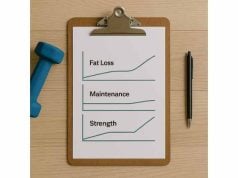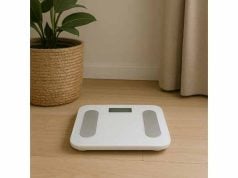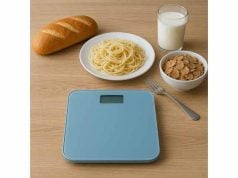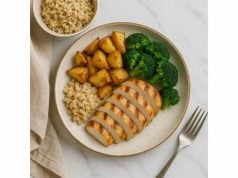
You tighten your plan and hit your steps, then the scale jumps for no clear reason. If that spike shows up at the same time each month, you are likely seeing a phantom plateau—temporary water retention from your menstrual cycle masking real fat loss. This guide explains why the scale misbehaves across the cycle, how to track properly, and what to adjust (and not adjust) when weight looks stuck. You will get phase-by-phase tactics, common pitfalls that fake stalls, and clear rules for when to talk with your clinician. If you are unsure whether you are in a true stall or normal fluctuation, run a quick check with our concise plateau and maintenance troubleshooting guide before you change calories or workouts.
Table of Contents
- Phantom plateaus and the menstrual cycle
- Track the cycle, not single days
- Water, glycogen and sodium explained
- Phase-by-phase nutrition strategy
- Common mistakes that fake stalls
- When to check with your clinician
- Two-week check to confirm progress
- FAQ
Phantom plateaus and the menstrual cycle
A phantom plateau is an apparent stall caused by water retention, not a true halt in fat loss. You may be in a steady calorie deficit, yet the scale rises or flatlines for 5–10 days—most often in the late luteal phase (the week before your period) and sometimes around ovulation. When the water leaves, your weight “drops overnight,” revealing the fat loss that was happening all along.
Here is what drives the illusion:
- Hormone shifts change fluid balance. Estrogen and progesterone influence the renin–angiotensin–aldosterone system, which regulates sodium and water. Late-luteal changes raise water retention independent of fat gain.
- Cravings and sleep wobble. Many experience stronger cravings, lighter or disrupted sleep, and lowered training drive premenstrually. Even if calories stay similar, these changes can increase glycogen storage and gut content, adding scale weight that is not body fat.
- Inflammation and soreness. PMS symptoms, increased muscle soreness, or period pain can slightly elevate inflammatory signals, which often correlate with transient water shifts.
What a phantom plateau looks like in data:
- Timing: repeats at similar cycle days.
- Speed: weight can jump 0.5–2.0% of body weight within days, then resolve within a week of bleeding onset.
- Measurements: waist or hip measurements change little; photos look the same; clothes feel similar except for occasional bloating.
- Performance: workouts may feel heavier; steps dip; sleep worsens.
Why this matters for your plan:
- Do not cut calories hard during late-luteal spikes. You risk fatigue, rebound hunger, and a rough following week.
- Judge by trend lines, not single readings. Weekly averages taken at comparable cycle points tell the true story.
If you want a quick refresher on safe energy targets before you adjust anything, skim our clear primer on healthy weight-loss basics. A solid foundation prevents knee-jerk changes when the scale plays tricks.
Key takeaway: A phantom plateau is water on the scale, not fat on your body. Expect it, plan around it, and protect your adherence in the days it appears.
Track the cycle, not single days
Most frustration comes from comparing random days. The fix is to compare like with like: weigh at the same points of your cycle and use averages, not single readings.
Set up your tracking once; reuse forever
- Mark cycle landmarks. Day 1 = first day of bleeding. Note approximate ovulation (common around Day 14 in a 28-day cycle, but your timing may vary).
- Weigh daily on waking. Bathroom first, minimal clothing, before food or fluids.
- Calculate 7-day averages for each week of the cycle. The average hides noisy day-to-day swings.
- Compare matching weeks across months: Week 2 vs. Week 2, Week 4 vs. Week 4. This isolates water patterns from fat loss.
Add two low-effort checks
- Waist/hip once per week (same time of day).
- Step count and sleep averages per week. Drops in either often explain cravings and fluid changes.
A practical reading guide
- Follicular weeks (post-period): expect the clearest fat-loss signal. Use these weeks to confirm progress.
- Ovulation window: a brief uptick is common; do not overreact.
- Late luteal (PMS week): the “phantom plateau zone.” Expect more variability; judge later.
What success looks like
If Week-to-Week comparisons show slow, steady declines at similar cycle points (for example, Week 2 to Week 2), your plan works—even if late-luteal numbers bounce. If everything is flat across two to three matched weeks, it may be time for a small adjustment.
For a simple routine that makes weigh-ins meaningful and low-stress, see our daily protocol for trend tracking: consistent weigh-ins you can do in under a minute.
Bottom line: Track patterns, not days. Match weeks across cycles, average daily numbers, and let your follicular weeks confirm real change.
Water, glycogen and sodium explained
Understanding what fills the scale helps you ignore false alarms. Three variables hide fat loss more than any others: water, glycogen, and sodium.
Water retention (hormone-driven)
- Late luteal: progesterone and estrogen changes alter aldosterone and vasopressin signaling. Your kidneys hold more sodium and water, often 1–3 pounds (0.5–1.5 kg) depending on body size.
- Period onset: many people release water in the first 2–4 days of bleeding; weights “whoosh” without any dramatic calorie change.
Glycogen (your body’s carb storage)
- Stored mainly in muscle and liver, glycogen binds water (about 3 g water per gram of glycogen).
- A higher-carb day, a re-feed, or simply better fueling around workouts increases glycogen and the water it holds. That can add 1–3 pounds temporarily with better training performance, not fat.
Sodium (the fast dial)
- Restaurant meals, salty snacks, and sauces swing water fast. Keep day-to-day sodium consistent to reduce false spikes.
- If you train and sweat, replace sodium deliberately around workouts to prevent low energy and lightheadedness; inconsistency (low one day, high the next) is what makes the scale noisy.
How these overlap with your cycle
- Around ovulation and late luteal, your body is already prone to hold water. On those days, salty takeout + poor sleep can stack with hormones and hide a whole week of progress.
- During early follicular (period week), you may see a sharp drop as water leaves and glycogen usage changes—again, not a fat loss surge, just clarity returning.
If you want a plain-English refresher on these moving parts, our explainer on water, glycogen and sodium keeps you grounded when the scale is loud: why the scale is not moving even when your plan is working.
Key idea: Most short-term weight change is fluid and fuel, not fat. Control sodium consistency, fuel smart for training, and judge progress where water noise is lowest.
Phase-by-phase nutrition strategy
You do not need a new diet every week, but small phase-aware tweaks make the month smoother and the data cleaner.
Early follicular (period days 1–4)
- Goal: reduce cramps and fatigue while you regain clarity on the scale.
- Tactics: keep meals simple and familiar, emphasize iron-rich foods (red meat, legumes, fortified cereals) paired with vitamin C, and hold sodium consistent. If appetite dips, protect protein first (25–40 g per meal) and accept slightly lower calories for a few days.
Mid to late follicular (days 5–13)
- Goal: capitalize on better energy and recovery.
- Tactics: place carbs around training (20–50 g in the pre- or post-workout window), keep fiber 25–40 g/day, and maintain protein evenly (1.6–2.2 g/kg/day). This is a good week to confirm the true fat-loss trend.
Ovulation window (roughly days 13–16)
- Goal: prevent overreaction to a brief water bump.
- Tactics: do not change calories in response to a 1–2 pound rise; keep hydration and sodium steady; continue normal training.
Luteal phase (days 17–28)
- Goal: manage cravings, sleep, and water retention.
- Tactics:
- Add 8–12 g fiber at dinner (vegetables, legumes, potatoes) and 10–20 g protein if evening hunger increases.
- Pre-plan a 150–250 kcal night snack (Greek yogurt and berries, cottage cheese and tomato, casein shake) to avoid grazing.
- Anchor three 10-minute walks after meals; movement improves mood and helps fluid balance.
- Keep caffeine earlier in the day to protect sleep.
If you want a simple macro framework to plug these tweaks into, start with our practical overview of maintenance-friendly macros and meal building: maintenance macros that keep you satisfied during fluctuating weeks.
Bottom line: Keep your base diet consistent, then nudge protein, fiber, and carb timing to match real appetite and training changes across the month.
Common mistakes that fake stalls
True plateaus are rarer than they feel. Most “stalls” come from a short list of fixable patterns that magnify water noise.
1) Sodium swings across the week
- Monday–Thursday: home cooking (lower sodium).
- Friday–Sunday: takeout and restaurant meals (higher sodium).
- Result: a Monday weigh-in “miracle” and a Friday “disaster,” even with identical calories.
Fix: keep sodium steady day to day; add extra fluids and a walk after salty meals, but do not crash-diet the next day.
2) Under-fueling, then late-night nibbling
- Skipping lunch or eating low-protein meals drives evening hunger.
- Late-luteal cravings plus low protein equals phantom plateau + real calorie creep.
Fix: distribute 25–40 g protein at lunch and dinner, add 8–12 g fiber at the final meal, and pre-log one planned snack. For targeted night fixes, use our focused guide to late-night snacking.
3) Weekend alcohol
- Alcohol adds calories, lowers restraint, and often comes with salty snacks—a perfect storm before PMS week.
Fix: choose alcohol-light weekends in the late luteal phase or swap to alcohol-free options. For more specifics, see our concise playbook on alcohol and weight stalls.
4) Paying attention to single lows, not averages
- Celebrating your monthly low and ignoring the weekly average makes normal rebounds feel like failure.
Fix: compare matched week averages; do not compare your follicular low to a luteal high.
5) Chasing the scale with cardio
- Adding random extra cardio when the scale pops up can worsen sleep and appetite and backfire.
Fix: keep training structured and repeatable; use steps and short walks as your flexible dial.
6) “Clean eating” drift
- Oils, dressings, nut butters, and bites while cooking quietly add up, especially when hunger rises premenstrually.
Fix: measure calorie-dense add-ons for one week each month to reset your eye.
Bottom line: Control the variables that shout the loudest—sodium, protein distribution, evening structure, and alcohol—and phantom plateaus stop feeling like emergencies.
When to check with your clinician
Most monthly swings are normal. Still, there are times when a professional review is the right move.
Consider a check-in if:
- You experience rapid, persistent swelling, shortness of breath, or unusual pain.
- Your cycle pattern changes markedly (much heavier bleeding, much longer cycles, or cycles cease for several months while not pregnant).
- Weight increases month after month despite stable calories and movement.
- You start a new medication and notice stronger appetite, heavy fatigue, or significant water retention.
Topics to discuss
- Whether symptoms suggest thyroid, iron deficiency, or other hormonal issues.
- Whether current medications are known to influence appetite or water, and what alternatives or timing strategies exist.
- How to evaluate your data (averages, measurements, training) without overreacting to single readings.
For context on prescriptions that commonly affect weight or appetite, use our patient-friendly overview to prepare for your visit: medications and weight plateaus. If your shifts align with perimenopause (usually mid-40s onward, but varies), our practical guide on midlife tweaks—nutrition, training, and recovery—can help you adjust expectations and strategy: midlife plateaus.
Safety note: Never start, stop, or change a prescription without medical guidance, and seek care promptly for severe symptoms.
Bottom line: Trust patterns, not panic. When patterns change or symptoms escalate, involve your clinician early.
Two-week check to confirm progress
When the scale gets noisy, switch from emotion to evidence. A short, structured review prevents overcorrection.
Your two-week audit
- Daily weigh-ins, same routine; compute weekly averages for Week 1 and Week 2.
- Match the phase (compare Week 2 follicular this month to Week 2 follicular last month).
- Log dinners and all post-dinner food for seven nights; note sodium flags (restaurant/takeout).
- Record steps and sleep averages.
- Take two photos per week (morning, same light).
- Measure waist or navel once per week.
Interpretation rules
- If matched-phase averages drop by ≥0.25–0.5% and waist trends down, keep your plan; you are losing fat even if the late-luteal scale says otherwise.
- If averages and waist are flat across two matched cycles, consider a small change: plus steps 1,000–2,000/day or minus 100–150 kcal/day, or redistribute protein and fiber toward dinner.
Make one change at a time
- Hunger high? Move 10–20 g protein and 8–12 g fiber to dinner; pre-plan a 150–250 kcal night snack.
- Training flat? Shift 20–40 g carbs to pre-workout or dinner the night before morning sessions.
- Sodium noisy? Keep condiments, sauces, and takeout consistent for one week before judging the scale.
For a broader diagnostic of true stalls versus noise and how to adapt calories safely, follow our simple two-to-four-week workflow: plateau check that keeps changes measured and reversible.
Bottom line: Use a two-week matched-phase check, adjust a single lever, and review again. This turns monthly swings into information rather than stress.
FAQ
How much can period water weight add?
Many people see 0.5–2.0% of body weight added from late-luteal water retention. The increase often arrives within days and fades during the first few days of bleeding. It is not fat. Use weekly averages and matched cycle weeks to judge true progress.
Should I drop calories when PMS weight spikes?
Usually no. Late-luteal spikes are mostly water. Cutting calories hard can worsen sleep and cravings, making adherence harder the next week. Keep protein and fiber high at dinner, plan a small night snack, and review trends after your period starts.
Why does weight jump after a high-carb day?
Carbohydrates refill glycogen, which binds water (roughly three grams of water per gram of glycogen). The scale may rise 1–3 pounds without fat gain, often alongside better training. Keep sodium steady and judge weekly averages, not single highs.
How should I weigh during my cycle?
Weigh daily on waking, then average each week. Compare matching weeks across cycles (e.g., Week 2 follicular to Week 2 follicular). Add a weekly waist measurement, step and sleep averages, and periodic photos for a fuller picture.
Can sodium alone cause a phantom plateau?
Yes. Large swings from takeout, restaurant meals, or salty snacks can add noticeable water, especially during late luteal. Keep sodium consistent day to day. After a salty meal, hydrate, walk, and resume your normal plan rather than crash-dieting.
When do I need to speak with a clinician?
Seek care for rapid swelling, new or severe pain, shortness of breath, cycle changes that persist, or month-over-month weight gain despite steady habits. Review any new medications that might affect appetite or water retention and discuss options or timing strategies.
References
- Management of Premenstrual Disorders 2023 (Guideline)
- Sex differences in the renin-angiotensin-aldosterone system and its roles in hypertension, cardiovascular, and kidney diseases 2023 (Review)
- Effects of sex and menstrual cycle on volume-regulatory responses to 24-h fluid restriction 2020 (Experimental Study)
- Fluid balance during physical work in the heat is not modified by the menstrual cycle when fluids are freely available 2023 (Experimental Study)
- Muscle Glycogen Assessment and Relationship with Body Hydration Status: A Narrative Review 2022 (Narrative Review)
Disclaimer
This article explains how menstrual cycle changes can affect fluid balance and scale readings. It is general education, not medical advice. If you have severe symptoms, major cycle changes, or medical conditions—or you use medications that affect appetite or water—seek guidance from a qualified clinician before changing your plan.
Share and follow
If this guide clarified your monthly weight swings, consider sharing it with a friend who is frustrated by “plateaus.” For practical checklists and future updates, follow us on the social platform you use most—Facebook, X (formerly Twitter), or another network you prefer.










